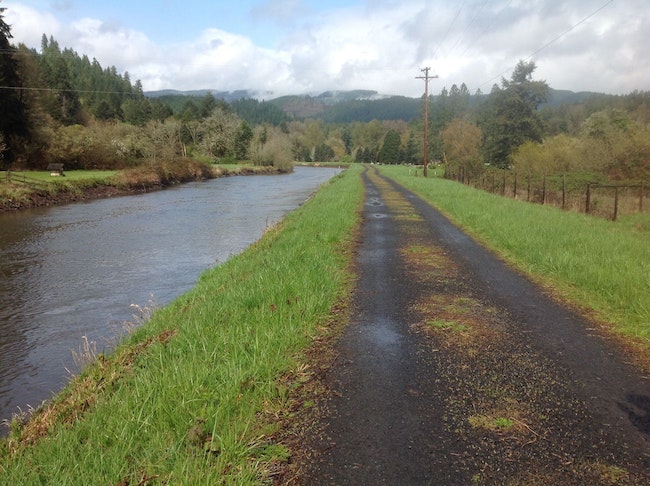 Photo courtesy of EWEBLeaburg Canal runs full all winter with stormwater runoff complicating the future of the canal for both power generation and stormwater conveyance.
Photo courtesy of EWEBLeaburg Canal runs full all winter with stormwater runoff complicating the future of the canal for both power generation and stormwater conveyance.
The Leaburg Dam and the Leaburg Canal Project, built by the Eugene Water and Electric Board during the 1930s, have been a presence in Lane County for almost 90 years.
The canal’s power generators produced the electricity that was an important part of building Eugene into a thriving city with its own dependable sources of electricity and drinking water that it is today.
The canal – and potentially the dam – might have reached their useful lifetimes. The EWEB is considering a variety of options that would have both fixtures’ impacts minimized or even eliminated – permanently returning the water once diverted at the dam into the canal, back to the main river channel.
The problems of the Leaburg Canal have been widely publicized; essentially, a section of the canal has been prone to seepage for the past decade. For safety, the water flow was cut off at the lake and the Leaburg canal was mostly drained in 2018.
And since the 2018 shutdown for seepage, the situation presented a number of expensive engineering challenges, and now more issues have been identified. A recent staff report also informed EWEB commissioners of some serious seismic challenges.
“Preliminary conclusions from those investigations indicated that the canal embankments could be significantly damaged during an earthquake. The seismic analysis findings, in combination with the known susceptibility of the canal to excessive seepage, increased the challenge of developing a safe, reliable, and cost-effective repair design,” said Joe Harwood, EWEB communication director.
Before these new seismic concerns, EWEB staff had floated the possibility that repairing the known seepage problem and bringing the power generator back online was already going to cost about $34 million. No value has been placed on making the canal earthquake-proof but it presents a significant issue for EWEB staff, commissioners and ratepayers.
Even if the canal ends up being decommissioned for power generation, there are several year-round creeks that were diverted and have drained into the canal since its inception. A small amount of water still flows down the system year-round, eventually joining the main McKenzie river.
For short durations in the winter a good portion of the canal can fill with stormwater runoff just from the side creeks. Recognizing the long-term problems, EWEB has made assurances that regardless of any future disposition the canal would always be maintained to safely carry stormwater runoff. EWEB officials said they are fully prepared to deal with any problem that might arise in 2020 or at any time before the future of the canal is decided.
In a spring EWEB commissioner’s teleconference, the possibility of also removing Leaburg Dam was mentioned. The most recent EWEB staff report spoke only to the issues of the Leaburg Canal. Without the canal many will question the need for the dam, which only provides a diversion for the canal and has no flood-control capacity.
The dam and canal have been blamed for declining salmon runs since being built. Improvements were made to aid returning salmon through the years, but critics have said they are not long-term solutions.








